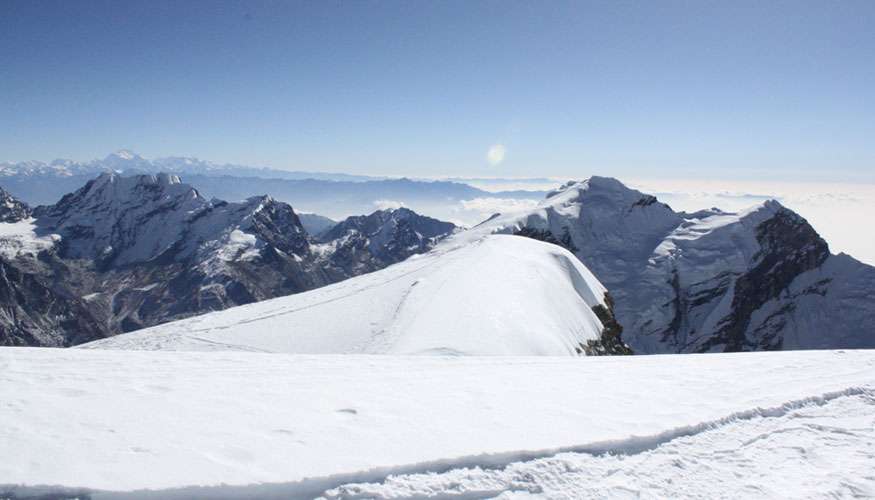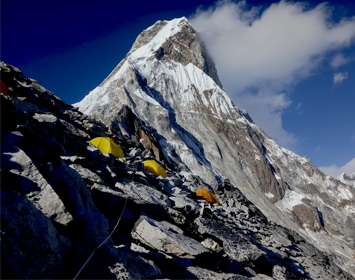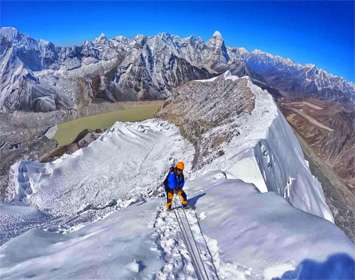Good to Know
Mera Peak Climbing route
Mera Peak Climbing begins with a short thrilling flight to Lukla. From here, you begin trekking on the opposite route of Everest Base Camp Trek. The trail passes through many villages like Paiya, Panggom, Nashing Dingma, Chalem Kharka, and Chunbu Kharka along with crossing many passes and dense forests. From here, you gradually ascend toward Hinku Valley and reach Khare. You will then climb to Mera Peak Base Camp via Mera La. Further, ascend to the High Camp and move to the summit of Mera Peak.
Best time to go Mera Peak Climbing
Spring and Autumn are the best time of the year to go on Mera Peak Climbing. March to May and October to November fall under these two seasons. Because of stable weather, moderate climate, and clear sky, trekking in these months is the peak time. You will see many fellow trekkers on the trail.
Mera Peak Climbing difficulty
Climbing Mera Peak is difficult. Even though the route requires basic technical climbing skills, the high altitude makes the journey more challenging. You have to walk a minimum of 5 to 6 hours a day on mixed terrain. As the altitude increases, the walk becomes more tough. You need to be in good health and physical fitness to go on Mera Peak Climbing.
Altitude Sickness Symptoms & Prevention
Mera Peak Climbing is a high altitude journey that involves a huge risk of altitude sickness. It is also known as AMS (Acute Mountain Sickness) and can happen to anyone regardless of age and physical fitness. To make sure, you do not have to suffer from AMS, we have added adequate rest days in our Mera Peak Climbing itinerary.
Below you can read about symptoms and prevention of altitude sickness:
Symptoms of altitude sickness:-
- headache
- nausea and vomiting
- dizziness
- tiredness
- loss of appetite
- shortness of breath
Prevention of altitude sickness:-
- Include an adequate number of rest days during the trek/climbing
- Avoid climbing more than 300-500 meters a day
- Make sure you're drinking enough water
- Eat a light but high-calorie diet
- Avoid alcohol
- Avoid smoking
- Inform your guide immediately so that he can take proper action on time
- Drop down to lower altitude and rest for a few days until symptoms getaway
Food & Water during Mera Peak Climbing
As it is a camping trek/climb, all the meals will be cooked and served by our crew members. Our team members are professionally trained in cooking delicious meals. We will offer you a good variety of food options during the journey and make sure you will get all the required nutrients & calories.
Accommodation during Mera Peak Climbing
Mera Peak Climbing involves camping throughout the journey. We will carry all the tents and the required requirements with us. We provide high-quality sleeping tents to all the team members with a common dining tent and toilet tent. The tents will be carried and set by our trained porters. As you will be traversing in one of the very remote areas of Nepal, the chances of getting decent accommodation are very low.
Mera Peak Climbing cost
The cost of Mera Peak Climbing involves facilities like meals & accommodation during the trip, permits, ground transportation, and expenses of guide and porters. The cost of the packages many other things that you can check our cost excludes & include a section for more detailed information. Feel free to get in touch with us anytime for further information.
Environmental Practices
The protection and preservation of the environment while running adventurous trips is very important for us. We take many different measures during our journey to the unspoiled Himalayas. From encouraging not to use plastic water bottles to carry our waste down to the cities to get it recycled or composted are few of the actions that we are taking.
Likewise, we also work closely with the locals of all the regions and help them either by providing a way to earn a living or donating. While traveling with us, you will not only explore but also contribute to the protection and upliftment of the region.
Mera Peak Climbing Packing List
We want you to know that you can rent or buy all the gears in Kathmandu. There are several options from medium range brands to high-end brands for all budget types.
- Clothing
- Sun hat/scarf
- Fleece jacket with wind-Stopper
- Waterproof shell jacket
- Down vest and/or jacket
- Lightweight gloves/Heavyweight gloves or mittens with a waterproof shell outer
- Light and expedition weight thermal bottoms
- Fleece/wool pants
- Waterproof (preferably breathable fabric) shell pants
- Thick, warm wool hiking socks
- Hiking boots with spare laces
- Sunglasses with UV protection
Accessories
- Sleeping bag rated to zero degrees Fahrenheit
- Trekking poles
- Headlamp
- Trek bag-pack
- Basic First Aid Kit
- Daypack
- Thermo-rest sleeping pad
- Water bottles
Climbing gears
- Climbing harness
- Ice ax
- crampons
- Mountaineering boots
- AscenderDescender/Abseil device
- Rope
- Snow bar
- Ice hammer
- Helmet (optional)
Toiletries
- Quick-drying towel/Small wash towel
- Soap (biodegradable)
- Toothbrush/paste biodegradable)
- Deodorants
- Face and body moisturizer
- Nail clippers
- Small mirror
- Tissue paper/toilet roll
- Anti-bacterial Hand wash
Extra
- Trail Map/Guide book
- Binocular
- Reading book
- Journal & Pen
- Pencils and small notebooks
- Camera with extra batteries



